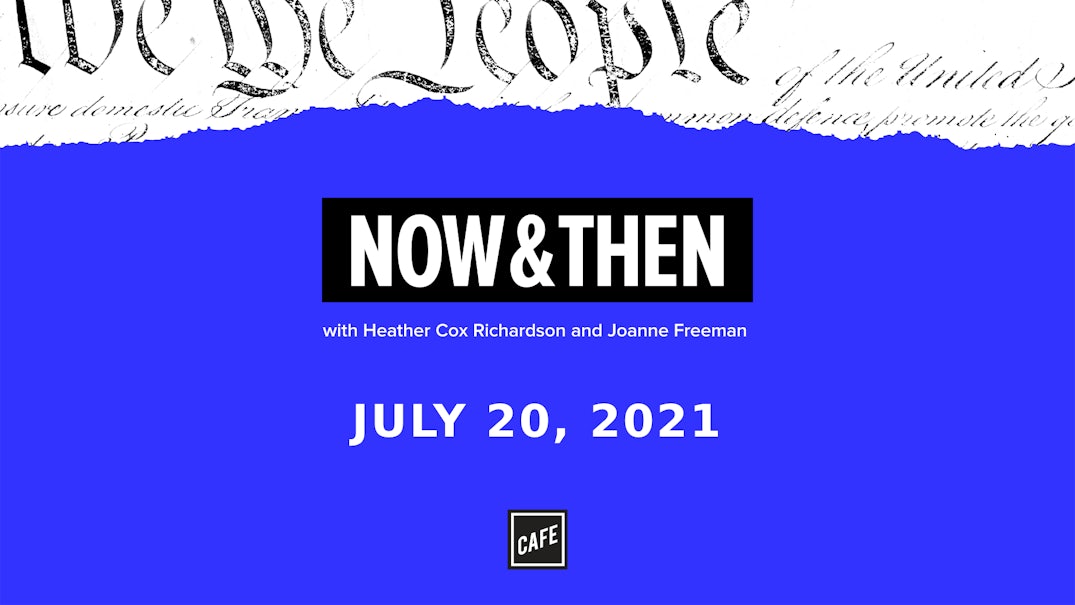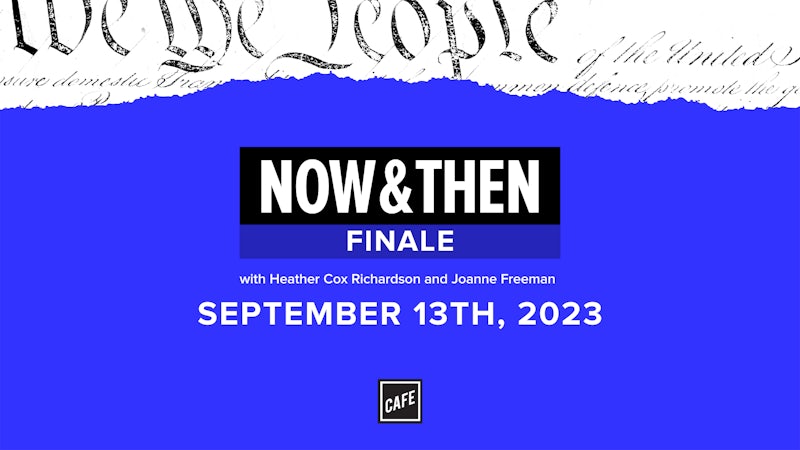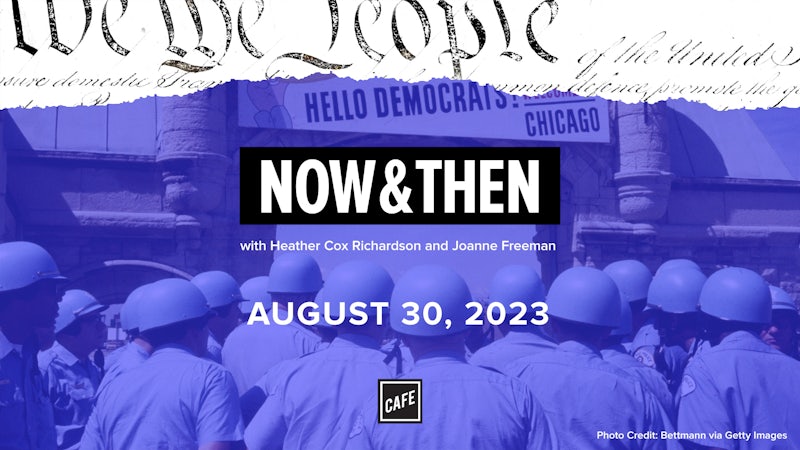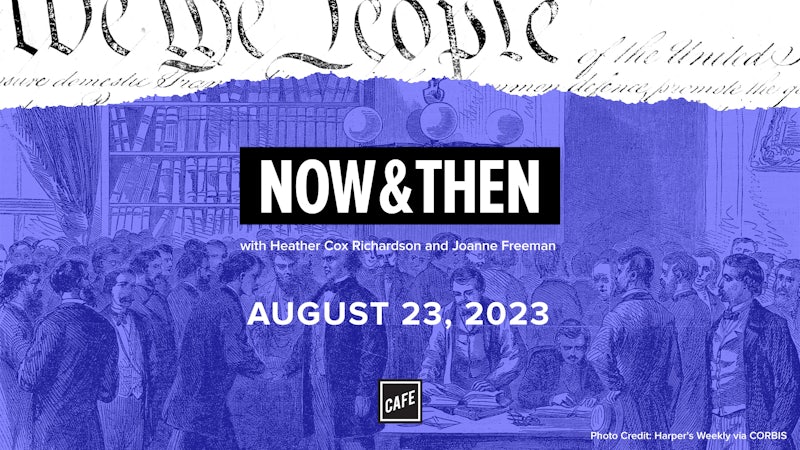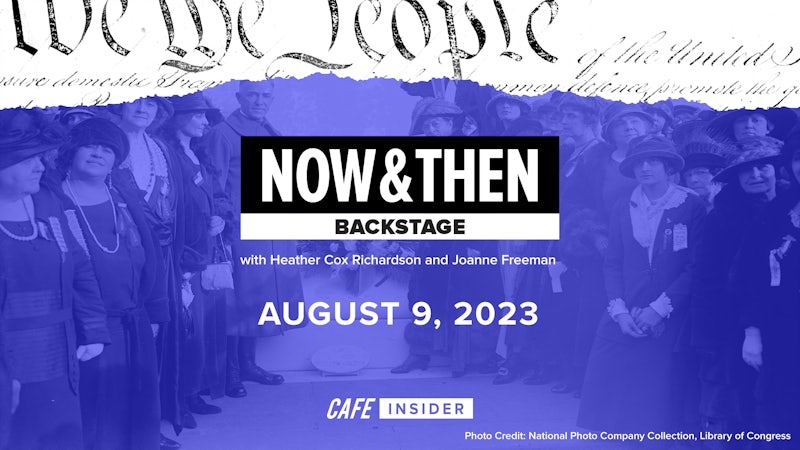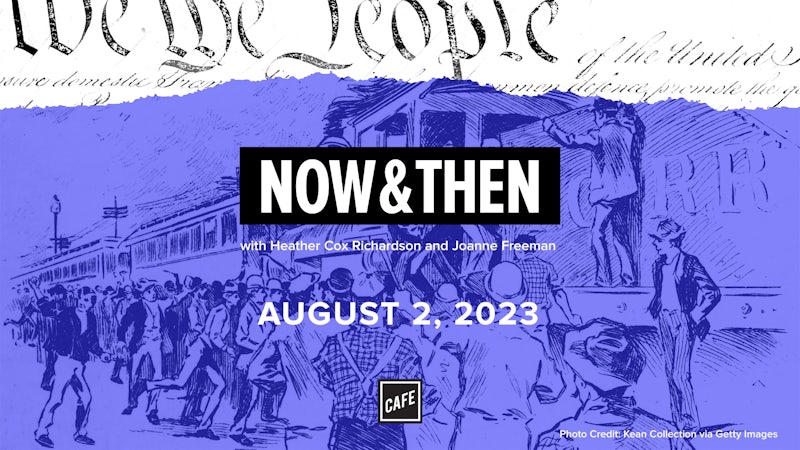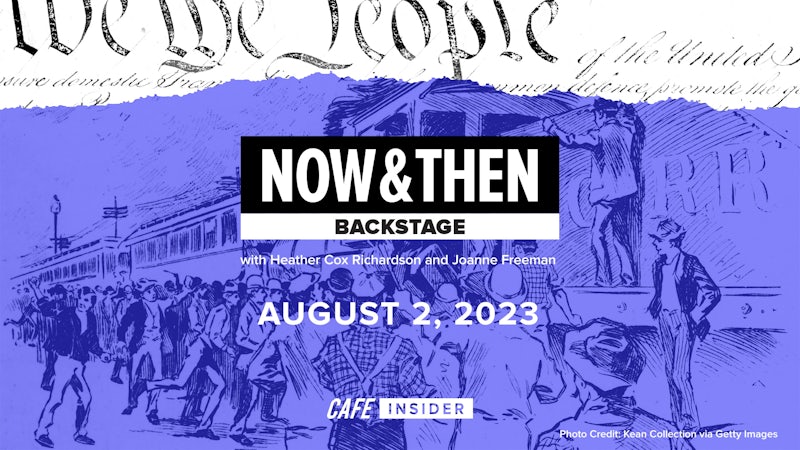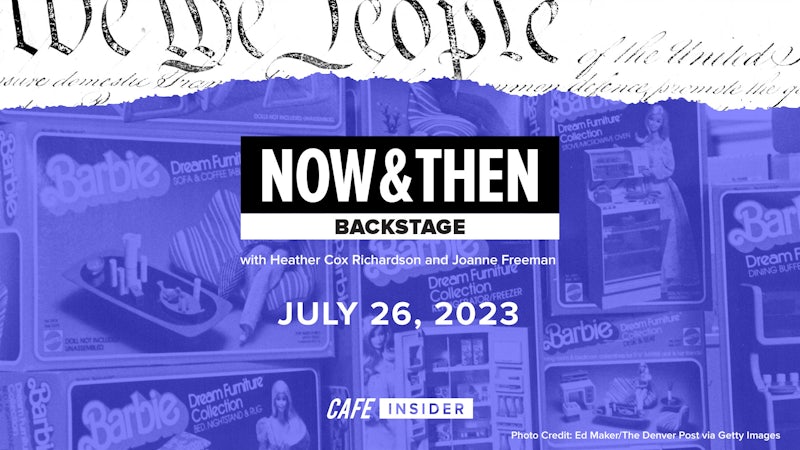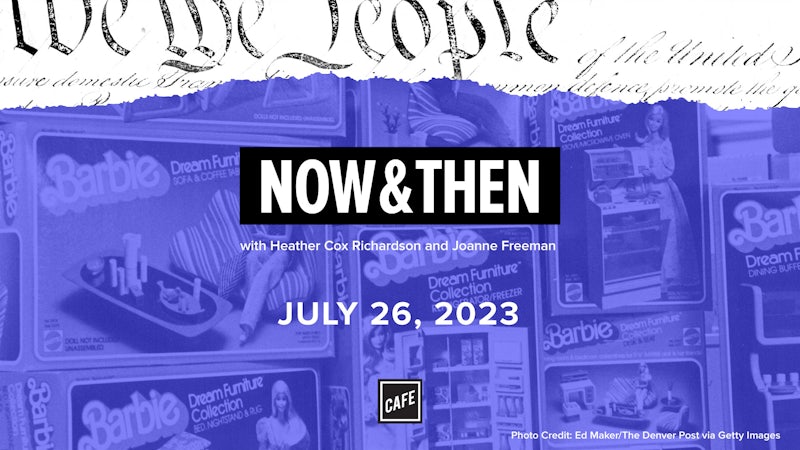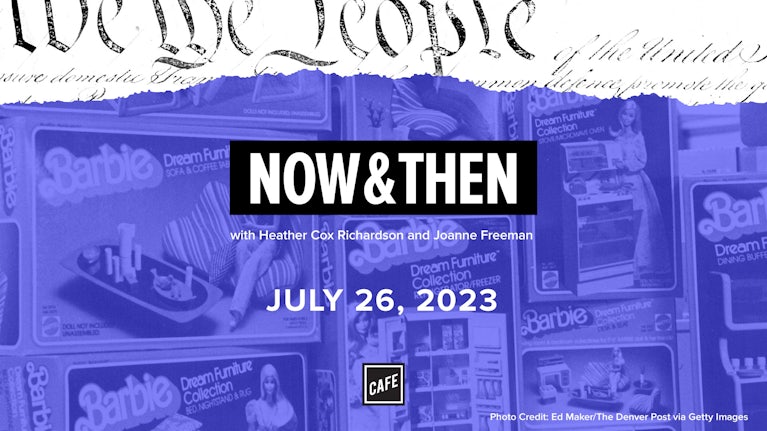Heather Cox Richardson:
From CAFE and the Vox Media Podcast Network, this is Now & Then. I’m Heather Cox Richardson.
Joanne Freeman:
And I’m Joanne Freeman. I want to just briefly introduce what we’re going to be talking about today, it’s actually a question that Heather and I have been tossing back and forth for a while, as we do, and in this case the question we kept asking each other was, how can you tell when you’re in a moment of great change generally, but more specifically, great cultural change? How can you tell when you’re in one of those moments? How does it work? What does it mean? And what can we learn from moments like that in the past?
Heather Cox Richardson:
Especially since so many times around us nowadays people are saying, everything seems to be changing, what’s going on? And you wonder, do people always feel like things are about to change or in the middle of changing? And so we sat down and we talked about how historians identify moments of change, especially cultural change, and try to figure out what the dynamics of those changes are. And one of the first things we came up with is that, oddly, times of change often are times in which there are two driving narratives, two driving competitive narratives that are trying to define what it really means to be in America. And then crucially …
Joanne Freeman:
Crucially, they’re defining what it means to be an American and very often they’re doing it with culture. And I want to talk about culture just for a moment at the outset here, it’s a little bit of a tricky thing to talk about because it’s a little nebulous, which is part of why it’s powerful. But as Heather just suggested, culture really has a lot to do with how we understand ourselves or how anyone understands themselves as a people. It includes assumptions, and beliefs, and habits, many of which you don’t even realize you’ve absorbed and are deploying in the way that you understand your place, your world, your nation, your people. It can operate on a pretty unconscious level. I think that’s particularly true with some of what Heather and I are going to talk about today which has to do with popular culture, which as we’ll see, part of the real power of popular culture is it doesn’t seem to be doing anything except entertaining us, but aha, it actually does much more than that.
So culture operates on an unconscious level, but for that very reason it really has power, it can really alter the way you think about yourself, your world, your nation. And so, in a sense, part of what we’re going to be talking about today is how to recognize and think about those moments and see how they’re working.
Heather Cox Richardson:
So literally, while we were talking about the periods that we’re going to be choosing to talk about, I’m saying to Joanne, “Let’s look at the economy of the time, let’s look at the division of wealth, let’s look at the GDP”, and she’s like, “No, you got to look at the movies.” That’s right. And so then I tried, “Well, let’s look at the political arguments”, and she’s like, “No, let’s look at what really made a difference.” So the first era that we … I mean, it wasn’t even a question, we had to start with was the coming of the Civil War.
Joanne, maybe you’d like to say a little bit about your guy from your last book and how he transitioned from being a proslavery democrat, right, into being a Republican in those 30 years before the war.
Joanne Freeman:
Right. And it’s a great example of the thing we’re talking about, the book is larking over my shoulder there, it’s called The Field of Blood. Part of what led me to work on this book is the character that’s at the center, who’s a pseudo guide, his name is Benjamin Brown French, and he starts out the book as what would have been called a doe face Democrat. He’s a northerner, he’s supportive of the South, he feels that the North and Northerners should have nothing to do with slavery, defining it, denying it, that’s a southern issue. He starts the book that way, and by the end of the book he’s a Republican and he goes out to buy a pistol in case he needs to shoot some Southerners for opposing what he thinks.
That’s a dramatic switch in not a lot of years, 1837 to 1860. He really undergoes a fundamental transition in what he thinks about the nation, what he thinks about the We that he belongs to, who he thinks are the other, and the fact that he can conceive of them as people who are enough of an other that they can be essentially shot at. So that’s the transition that Heather and I are interested in here, which is, how do people undergo that really fundamental change of thought, and in particular, in this dramatic period, the 1850s, what helps that transformation?
Heather Cox Richardson:
What made him transition?
Joanne Freeman:
He gradually began to lose faith in the Southerners. He began to feel that they didn’t follow through on their promises, that they put the South before they put loyalty to Northerners, the fellows in their party. He basically began to feel that he couldn’t trust them because they were out for themselves, and thus, why was he supporting them if they were only serving themselves and no one else.
Heather Cox Richardson:
Well, so that’s really interesting because one of the narratives that goes forward before the Civil War and that really seems to be dominant going into the 1850s is the idea that the Great Americans are white, Southern enslavers. The framers of the Constitution, the people known as the founders of the nation, the Washington’s, Madison’s, Jefferson’s, and a lot of especially Southern Americans really double down on the idea that, that’s what it really means to be an American. And literally, by 1858 you’ve got James Henry Hammond standing up on the floor of the Senate and saying, “Listen, the way America really should be is a few of us should really run everything because look how well we’re doing, and look at all the wonderful stuff we have, the paintings on our walls, and we’re getting education. And look, we even have olive oil”, which is incredibly exotic at the time.
And yet there is a competing narrative that starts to grow really in the 1830s but really takes off in the 1850s, that in fact, that’s not what America is supposed to be about. And one of the things that really drives that is a novel written in 1852 by a woman named Harriet Beecher Stowe, who writes Uncle Tom’s Cabin. And Uncle Tom’s Cabin is a portrayal of human enslavement that is political, I got get that in there, that is illustrative of how dangerous The Fugitive Slave Act from 1850 is, but it is also profoundly human, and that’s going to make a really big difference in the way people think about the South and human enslavement.
Joanne Freeman:
And that’s one of the things that I’ll mention now and I know it’s going to come up again and again, that’s one of the powerful things about Uncle Tom’s Cabin, is that it’s human, it touches emotions. And anything that can touch you on that emotional level has a real power to it. That’s some of what you see with Uncle Tom’s Cabin, you see it with any number of things, you’re certainly nowadays seeing examples of how keying people’s emotions could create responses that are enormous and sometimes even out of league of what’s happening. But in this case, by touching on emotion and by touching on, among other things, the power of women to make change, the power of women to operate in the area of slavery and antislavery, it adds an intensity and alters a little bit the We, and in doing that, begins to change the narrative of how some people understand what’s going on at the time.
Heather Cox Richardson:
Well, and so, it does it very deliberately. Harriet Beecher Stowe, when she writes Uncle Tom’s Cabin, deliberately writes it for a new audience. She is writing it largely for white women and largely for middle class white women. And one of the experiences that every woman in America who bore children in those days was fear that their children would die or the actual death of their children. In the days before penicillin, children didn’t always live that long and they died messy, horrible deaths. Deaths of dehydration and everything that goes with that, that now of course, in America, we handle pretty easily, but you had to expect that you would lose a child.
So the centerpiece of Uncle Tom’s Cabin in the first half of it is the story of this little girl, Evangeline or little Eva as she becomes known. And when people read that book nowadays, I often teach it and students always roll their eyes at little Eva because she’s uuii and aaii, and she never does anything wrong, and she’s always just beautiful, and she’s perfect. And the whole point of that, and I’m sorry this is going to be a spoiler, is that little Eva actually dies. And in the process of her death, what she has done before that is her father has purchased Uncle Tom and she is arguing for his freedom.
So she on her deathbed is begging for this man’s freedom, and as she does that, and as she has this ethereal death where the angels come down and little Eva rises up into the clouds, again, for a modern eye that’s like, come on, but in those days, if you had just witnessed as Harriet Beecher Stowe had within the year before she wrote this book, the death of your own child in these horrific ways, you looked at the death of little Eva and you were like, this is what I always wanted for my child, this is what I want to imagine for my child.
And another piece in the book is the threat of the loss of her child from an enslaved woman whose child is going to be sold away from her. And so you start to empathize with this mother as her child is literally going to be taken away from her. And so, Harriet Beecher Stowe taped deeply into that maternal child fear and the idea of somebody losing their child because of politics. I mean, you look at this and you’re like, really, really, you’re going to let some politician step in between a mother and a child. And there’s also a politician in the book who comes around and says, “You’re right, this wasn’t such a good idea. I’m dealing with real people, I can’t go ahead and let this happen.”
Joanne Freeman:
But think about that, because it goes back to what I just said a moment ago, what can be more powerful emotionally than the death of a child in this way? As Heather you just said, it’s something that is expected in the period, there’s a whole genre of photograph in this period of dead infants, they die-
Heather Cox Richardson:
It’s truly awful.
Joanne Freeman:
It is truly awful, it’s horrible, and that’s what I’ve been thinking of as you’ve been talking, was those horrible images. But what could be more heartbreaking, what could grab at you more than children, the suffering of children, the death of children. So in making that, putting that at the center of this novel, even though it is a story about an enslaver and about slavery, it wraps you up in what’s happening because of the characters and then you become involved in the rest of the story as a consequence.
Heather Cox Richardson:
And then, of course, not to short Uncle Tom, he becomes a Christ like figure, and one of the reasons that he becomes a Christ like figure is because his determination to protect the other women in the novel who are being sold into sexual slavery. So it really plays on your emotions this book, especially the emotions at the time. I also feel like I should wrap up the idea of the photographs of the dead babies and dead children, that’s because if you lost your child you would have no memory of the child, literally something to remember that child by except its clothing and once we get types pictures of the child. So there actually was a whole genre of I lost my child, I’m going to take a photograph of it. They’re very, very sad. They’re very creepy, they’re also very sad.
Joanne Freeman:
They are. They’re just upsetting, which is why it jumped into my mind as soon as we were talking about this because you can feel the pain and the loss in those photos.
Heather Cox Richardson:
It’s just heartbreaking. But anyway, she writes this book, she’s up in a newspaper, abolitionist newspaper in 1851, it becomes serialized in 1852, and it goes off the charts, if there were charts in those days. It sells about 300,000 copies in the United States, and there’s going to be pirated copies of it all over the world. And it ultimately becomes the best selling book in the 19th century other than the Bible, and it’s going to be displaced by another book we’re going to talk about in just a minute.
It was important enough that Abraham Lincoln allegedly said to Harriet Beecher Stowe, “So you’re the little woman who wrote the book that started this great war.” But maybe more important in terms of its effect is to take a look at what it did to P.T. Barnum, you’ll probably all know about P.T. Barnum who was this great huckster of the 19th century who actually began his career by, as they called it then, renting an older African American woman named Joyce Heath and began to advertise her as being the nurse to George Washington, that’s actually how he got his start. After Uncle Tom’s Cabin and after the increasing power of this narrative, the human enslavement was a sin as well as a politically inexpedient, P.T. Barnum changes his tune and starts to stand against human enslavement by the late 1850s. And lots of people think he had an emotional conversion, no, he was a huckster.
Joanne Freeman:
Exactly. I mean, if you just think about, again, culture and what his transition suggests, he’s literally banking on her to make money and advertises her as this 161 year old former nurse of George Washington, and makes a lot of money based on that, and becomes renowned based on that, and then in the end it’s found that she was probably about 79 years old. But the fact that he’s making money off of that, assuming that people are going to be interested in history, slavery, they’re going to want to come and see this, and that then later he makes this transition when the nation is about to enter Civil War around the time of secession, and changes, becomes a republican, alters his politics and his, I don’t want to say his feelings actually, alters his politics, in part, because he is going where the people are going, he is going where the money is going.
He writes, I think, a autobiography at some point and he says even at that late phase, “I considered myself a Democrat but I thought it was time”, for what he called it, “a new departure as secession comes around.” So he is doing what a huckster or someone living on popular culture needs to do, and that is, he’s going right in the direction of where public interest and popular culture is going.
Heather Cox Richardson:
So he sees where the parade is going and he gets out front. By 1859, he’s actually starting to lionize John Brown, which is a long way from where he started because he saw the direction that things were going. So there’s a case where you have two competing narratives and we get a dominant narrative that goes ahead and says that human enslavement and statement of hierarchies in society is a bad thing and popular culture is going to go down the angle of trying to make America more equal.
Joanne Freeman:
I want to raise one point before we leap to that other novel that’s lurking there, I can see it waiting for us to talk about it. But I do want to make the point with Barnum that, in lionizing John Brown, when you read about what he did to celebrate, literally, John Brown, again, it’s not just, let me tell you about John Brown, it’s playing up the emotion and the accomplishment in a way that is intended to grab people.
When Heather and I were reading, and talking, and preparing for this episode, one of the things that we found that some of the wonderful researchers who work for this production found is that two statements by Frederick Douglass that show this idea of the power of culture in a really strong powerful way. So initially, as one would expect, when he’s looking at popular culture that involves African Americans in particularly minstrel shows, these highly, I don’t even know what to call them, extreme cartoonish versions of African Americans and there are songs that go along with them, that a lot of people know, that are meant to pull at your nostalgia, the South, he initially, as one would expect, says, “What a bunch of hooey.” This is suggesting that there’s this glorious, romantic self and it’s doing slavery and the whole idea of slavery a disservice.
A few years later he actually says in a statement that the one thing you can say about minstrel shows is that they affect your sympathies, they affect your emotions, they touch you in a way that other things don’t, and because some of them actually were antislavery, he’s pointing to the very thing that Heather and I are talking about now, which is that culture has a power that needs to be acknowledged and potentially used.
Heather Cox Richardson:
But if that’s a case where culture went in one direction, there’s another obvious case where culture went in the other direction. And that happens in America in the early 20th century when we rewrite the history of the Civil War and Reconstruction to say the opposite of what really happened. And we picked this one in part because there was such great material in it, but partly because, of course, we are now in a period that looks back at that moment and says, wait a minute, we got to reevaluate this. And what happens there around the turn of the century is a rewriting of reconstruction. A rewriting of reconstruction that says that African American rights were a bad thing for America, that when they got the power to vote, for example, African Americans used it to create a behemoth government that offered them stuff like roads, and schools, and highways that gave them advantages that white people didn’t have, and that cost white tax dollars.
And that gets written into the history very, very deliberately. That is in a deliberate attempt to rewrite our history, first in 1890 by Southern congressmen, and then in the early 20th century by historians who are sympathetic to the South. And the obvious place to look for with that is Thomas Dixon. Thomas Dixon is a minister in the South and he writes a very famous book in 1905 which has a title that you just got to go to the mat for, it’s called, The Clansman: A Historical Romance of the Ku Klux Klan, which obviously is a positive portrayal of the Ku Klux Klan in the South after the American Civil War to suggest that they were the heroes of reconstruction, not the other way around.
He writes The Birth of a Nation about 10 years later and it’s going to become a movie, but the Klansmen becomes really important because there’s a girl at the time who reads the Klansmen and is so enamored of this book that she starts putting on plays about it, she starts thinking a lot about it, she starts thinking, gee, we ought to have a really big book about this. And as she is thinking that, more and more people who are trying to control our narrative decided to advance this idea of what really was important about the reconstruction period in the South was the fact that a few brave Southerners, not generals necessarily, but individual Southern soldiers stood against this growing government, they pushed back against the idea of being taken over by this behemoth government. In fact, we ought to have statues about them. And this is why from 1890 to about 1920, we get the vast majority of our Confederate Statuary in America. And if you think about it, most of them are foot soldiers, not generals, although we get generals too.
Joanne Freeman:
But I want to highlight that because, obviously, and we’re going to come back to this, there’s so much focus right now on the statues, Confederate statues and the fact that if we get rid of them they eliminate our history. In many ways, they are the history of this moment in time when people are trying to create this narrative about these Southerners who stood up for the rights of the forefathers, and not necessarily the great generals, but what to these people, the South and the lost cause, the Confederacy, represents. So the statues are meant to tell a particular story. And it’s a powerful story, it’s a story so powerful that in many ways what we’re responding to now as a nation is that story. But it’s important to realize these statues are not from the history or about the history, they’re really testimony to the people deploying history to serve a purpose.
Heather Cox Richardson:
And that purpose was to guarantee that the government did not act in defense of the rights of black people. So they do that very deliberately. And then that woman I set up who read Thomas Dixon is, of course, Margaret Mitchell. And in 1936, she goes ahead and publishes her first novel and her only novel, it’s over 1,000 pages long and it is called, Gone with the Wind, and that’s going to knock Uncle Tom’s Cabin out of the top space as the most popular book in America except the Bible until the modern era, but we won’t talk about the book that does that. She expected it would sell only about 5,000 copies, after all, it was over 1,000 pages, it sold more than a million copies in the next six months. It also won the National Book Award and the Pulitzer Prize. And then, three years later, it’s going to become a movie, and I want to turn the movies over to Joanne.
Joanne Freeman:
So it becomes a movie, and along the lines of what we’re talking about here, all of us have experienced the power of sitting and watching a movie that you don’t necessarily know is going to be there when you watch it, but you come away sometimes being haunted by what you see on film. In this case, the film is this grand drama with huge … the sets, and the plantation, and the gowns, and the dresses, and everything else, I bet that probably the majority of people watching us right now have probably seen it. But I want to read the opening title card of the movie because it really captures exactly what Heather and I are talking about right here. And I bet a lot of you remember this as I start to read it.
So when the movie starts, these are the words that flash on the screen. There was a land of cavaliers and cotton fields called the Old South. Here in this pretty world, gallantry took its last bow. Here was the last ever to be seen of knights and their ladies fare of master and slave. Look for it in books, for it is no more, a dream remembered, a civilization Gone with the Wind. That if you’re looking for a statement that sums up what this movie was really trying to do, that does it, right. It’s creating this moment, this supposedly romanticized, longed for moment in the past, telling the story that pulls you in, partly through the characters like Scarlett O’Hara or Rhett Butler, right, get you involved, emotionally involved. But think about the story that it’s telling and think about what it is saying about slavery and about African Americans, that was an issue from the moment that, that film came out.
Heather Cox Richardson:
And I have to say, it pulled me in emotionally to the point that three minutes in I’m like, oh, my god, I can’t believe I have to watch any more of this, and it’s like six years long. I can’t sit still anyway. And I had to teach it as a TA for Professor Donald and I’m like, oh, my god, you can’t make me watch this whole movie. And of course, I had to watch the whole movie and I’m like, please God, let this war be over. So I don’t think I was their target audience.
Joanne Freeman:
No. But here’s my question, so how did the students respond?
Heather Cox Richardson:
This is the worst part. I went into class and I hope none of my students is watching, fully prepared to make fun of it, right, because I’m like, oh, my god. And there was a woman, she was not a normal undergraduate age, sat down next week and she was in tears and she said, “Oh, my god, I love that movie. I’ve seen it 25 times and I love it more every time.” I’m like, “Oh, god, we’re in trouble now.” And I will say that if you have not seen it, everybody should go watch Went with the Wind, which is Carol Burnett, that is brilliant off the charts. But you have to see Gone with the Wind in order really to appreciate Went with the Wind, and Vicki Lawrence is great in that, they’re all great in that.
Joanne Freeman:
And I bet a lot of you know, you’re imagining and I’m not going to say anything to give it away.
Heather Cox Richardson:
Yes, don’t give it away.
Joanne Freeman:
You’re totally imagining what it is.
Heather Cox Richardson:
Best moment in TV history.
Joanne Freeman:
It is.
Carol Burnett (archival):
As God is my witness, these Yankees aren’t going to beat me.
Joanne Freeman:
But what’s interesting, as you were talking about hating it and your students or at least that one student loving it, I’m wrestling with my response because I think I saw it when I was little, you were older at that time, you’re being a TF I guess in graduate school.
Heather Cox Richardson:
Yes, I must have been 30.
Joanne Freeman:
I saw it as a kid and was just sucked in. And I’m sure I was sucked in by the title, Gone with the Wind, and did exactly what a wide audience was assumed to do with that movie. And at a later point, when I saw it again, then I became supremely uncomfortable with it. I have not seen it 25 times, I’ve probably seen it two or three times, but just in between time number one and time number two, my awareness of American history, and of slavery, and of what this movie meant, and of the power of movies, I had a dramatically different reaction. Now, one of the things I want to point out, because you and I we’re talking about our feelings about it now, and that’s an important thing to think about when you’re thinking about history, and that is how long standing, how long lasting, powerful cultural narratives can be, and Gone with the Wind is a great example of that.
One of the things that I uncovered in rummaging around and preparing for this episode was the fact that in 1974, so in preparation for the US Bicentennial, NBC paid $5 million, a record smashing $5 million, which supposedly today is more than $26 million, for the right to show the film once as part of its Bicentennial programming, which is mind blowing, right. I didn’t know that before. And apparently, 47% of all American households watched that movie. Think about that, right. Think about the fact that huge expenditure of money to show this film that in some way or another is being linked with America’s grand past. Nubi, my parakeet totally agrees at that point, he just chirped.
Heather Cox Richardson:
Well, it is also interesting that we have such strong feelings about it, because I could sit here and I could root in that movie till the cows come home. And really, who cares? In terms of, why do I have a visceral reaction to a movie that I saw that one time so I could refer to it when I taught it? And I’ve certainly read about it and written about it, but I do still have a very negative visceral reaction. I mean, I found them all annoying, except Rhett Butler. And the idea that anybody would choose Ashley Wilkes over Rhett Butler was like, oh, come on.
Joanne Freeman:
Really?
Heather Cox Richardson:
But anyway, I’ll stop now.
Joanne Freeman:
Really?
Heather Cox Richardson:
Well, come on.
Joanne Freeman:
No, it’s really true.
Heather Cox Richardson:
But the important thing for me about Gone with the Wind in 1939 is that, that was, people argue, one of the best years in American movie making because we had five blockbuster movies that year, we have Mr. Smith Goes to Washington, we have Geronimo, we have the Wizard of Oz, we have Gone with the Wind of course, and then we have Stagecoach. And all of those movies are movies in which an individual, in everything except Gone with the Wind, somebody who’s just an average person and every man is taking on the government, is going ahead and creating their own future, when she’s holding up the radishes and waving them … I’m sorry, I’ll stop. But is creating their own-
Joanne Freeman:
You’re really in there now, Heather, you just got sucked right back into Gone with the width.
Heather Cox Richardson:
Here we go, there’s even a scene in Geronimo where, theoretically, in this movie that Geronimo is incidental to it, but theoretically, Geronimo is causing trouble for the Euro Americans in the film, but he’s actually set up to cause trouble by a government Indian agent. And there’s all these moments like in Mr. Smith Goes to Washington, right, the government is corrupt and there’s this individual guy who in the script is from somewhere in the West goes and takes on the government. And the Wizard of Oz [crosstalk] these individuals. Yes, go ahead.
Joanne Freeman:
No, totally, because that’s what leapt into my mind in the Wizard of Oz, and this is really obvious. It hits you a different way in the context of this conversation. That is a movie about a girl from Kansas and her friends who go to the great and mighty Oz who is revealed to be a totally fraudster, a con man, this leader, this all powerful leader, IE. the government, IE. the president, right, is nothing. It’s these people who come and confront it and draw aside the curtain and reveal that behind all of the huha and the pump is just fraud. Think about that message which of course, again, as with Gone with the Wind, depending on how you’re watching the Wizard of Oz, sitting around with your family having popcorn, that’s probably not the first thing that comes to mind, but that’s really powerfully what that movie says.
Heather Cox Richardson:
And all the movies at that time. The idea of these individual people doing it on their own, making it without the government, this is during the New Deal, they’re not making it without the government. But this idea, this almost reactionary idea to the government that is helping people, that this is the narrative because of the power of culture that comes out of it. So we’ve talked about one era in which popular culture pushes a narrative of inclusion, pushes a narrative that says that we should expand American rights, is against the ones that the elite Southerners are pushing. And then we have this one where the opposite wins, where we get this reactionary idea that the government shouldn’t be doing anything to help people, that in fact, we’re all doing it on our own, even though that’s wrong. This image of the South where the good guys are the enslavers, the bad guys are the enslaved, I mean, all of those things are really reactionary story.
Joanne Freeman:
[crosstalk] Before it brings us, I want to highlight what you just said, you said wins, one narrative wins. And what we’ve just been showing is how culture helps lead to the blossoming of one particular narrative. Okay, now, tell us what that leads to.
Heather Cox Richardson:
Now.
Joanne Freeman:
Exactly. Thank you very much. Yes. And it’s not going to be a surprise to anyone that we’re talking about changing cultural moments and competing narratives. And this seems like a story that has a lot to do with the current moment, indeed, it does.
Heather Cox Richardson:
When we have two highly polarized narratives about what America should be and people trying to define that narrative and get people on their side to advance it. So on the one side, you’ve got people who are now firmly in the camp of Donald Trump and the former president, who are running, for example, in 2022 on the idea that they’re going to protect God, and the former president, and guns, and really hitting again and again on cultural issues, culturally narrative issues. So for example, we tried Mr. Potato Head, that didn’t go very far, we tried Dr. Seuss, that didn’t go very far, but what they’ve got their teeth in now in terms of creating a narrative is the idea that somehow critical race theory is being taught in the schools and that is advancing a narrative of America that is deeply divisive and that is ultimately hurting our children, back to that idea of children.
Joanne Freeman:
Exactly. And grounded on a story, right, the creation of a narrative, we’ve all seen and actually hear on now and then, we’ve even talked about what critical race theory really is versus what it’s being portrayed as now for cultural impact so that people can feel our values are being threatened, we have to join together and attack. It’s being used as that kind of a cultural weapon and it has some power as that kind of a weapon.
Heather Cox Richardson:
And states are passing laws saying that you can’t talk about divisive information or you can’t talk about divisive things in schools, which is really deeply problematic because everything we do has the potential to be divisive as historians, because we’re talking about people and people don’t always agree about everything. So who gets to define divisive? And once again, critical race theory is a legal theory that it was limited to law schools until it seemed to create a narrative that might be able to drive the majority of the American people in a way that would have a political payoff?
Joanne Freeman:
And what’s interesting, and this is one of the things Heather and I, we were talking about way back when we were first thinking about this topic, is there’s almost no more dramatic way to see competing narratives competing right now for what America means and who thus is supposed to be the winner of this moment. The best way to see that is in the battle we’re having right now over education, because that battle about what stories do we tell in schools, who gets talked about, who doesn’t get talked about, what’s allowed to be talked about, what gets crossed out or not talked about? What is the story of America that we want our children to learn? That is what Heather and I are talking about here smack in your face.
That’s two sides saying, this is the story of the United States that needs to be told. One side wanting to include things that actually happened in the past like race, and slavery, and challenges to some of what was presented as an ideal in the period, and others who really just want to focus on ideals. Two very different stories. Some of the fighting going on right now about what story of the Alamo should be told, there’s a traditional patriotic story and then a book that just came out that suggests, no, actually slavery was bound up in it. We are in the middle of not only a cultural battle, but one that is happening right in front of us and that legislation is responding to. So as far as a cultural weapon that has some grip, this one, education and what story we want to tell about ourselves is a big one.
Heather Cox Richardson:
Well, and it’s fitting that in this moment, one of the things that has symbolized a changing narrative is the removal of Confederate Statues. And this is a point I always like to make when we talk about Confederate Statues, everyone’s always asking about it, is that generally when statues come down, you’re looking at regime change. Think about it, anytime you see an attack on a government, when the statues come down it means that there’s a different set of people in power. And there have been about 270 Confederate symbols that have come down in the last several years although it’s gotten a lot of press, there’s still about 1,600 that remain, but they very visibly come down. And of course, in 2017, it was the fight over the removal of the statue of General Lee in Charlottesville, Virginia that sparked the unite the right rally that became such a defining moment for the previous presidency. And I just want to point out that on Saturday, July 10th of 2021, that statue did finally come down quietly, I believe, but that one is down.
So we’re taking out the same statues that people put up in the 1890s through the 19 outs and the 19 teens, but that’s not the only part of a new narrative that is developing right now. And the other thing that really jumped out to Joanne and me, first of all, when we were talking about Uncle Tom’s Cabin, believe it or not, was the reactions in America to the murder of George Floyd and how people responded to the murder of George Floyd.
Joanne Freeman:
Absolutely. I mean, we all saw and recognized the intense response on all kinds of levels to the murder of George Floyd. And the Black Lives Matter Movement, which initially emerged in 2013 on social media, in response to the acquittal of George Zimmerman in the shooting of 17 year old, unarmed, black teen, Trayvon Martin grew even larger. But what was interesting, and Heather I think you were the one who brought this fact to my attention, which is that according to a Pew Research poll of people who attended a Black Lives Matters protest, 46% were white, which is really interesting, not what you would expect, and suggests white people responding in a different way to this history than perhaps they had done before.
Heather Cox Richardson:
And that begs the question in a way. I mean, that’s one of the things that Uncle Tom’s Cabin did was that it got people who would not have been involved in politics and almost certainly would not have been involved in abolitionist politics, involved in the system, way back in the 1850s, to stand against the expansion of slavery, and it was really the mobilization of that white population around Uncle Tom’s Cabin. I mean, one of the things I just like to point out about the Black Lives Matter movement is that the killings of black Americans by white law enforcement officers is nothing new. I mean, this has been going on forever. And that always begs to me the question of, why now? Why has that become a cultural moment now when it could have become a cultural moment over so many other issues, not simply back to the Tamir Rice, for example, or back further and further, but all the way back to the beginning? Why now?
Joanne Freeman:
One of the things when we were talking about this, certainly not the only reason but one reason, I think, has to do with technology, which is now because of cell phones, white people could see for themselves something that people of color have known for a very long time, but they saw it. And the George Floyd story was so over the top, so dramatic, and so horrible that, that ended up, I think, standing in for a lot of other things that were getting more public attention because there was someplace for a white population to see them and put it in front of them in a way that they perhaps hadn’t seen it before.
Heather Cox Richardson:
I would suggest that there was something else in the killings of the last few years that may have affected people in my generation because seeing Mr. Floyd die was simply horrific, but it was actually the murder of Breonna Taylor that did me. I mean, it really did me in. I spend a great deal of time now every day thinking about the murder of that woman, because she’s my daughter’s age. And she could have been my kid. And there you have again [crosstalk].
Joanne Freeman:
Brings us right back to children.
Heather Cox Richardson:
It goes right back to children.
Joanne Freeman:
Yes.
Heather Cox Richardson:
Literally, it’s like somewhere there’s her mother walking around out there and I obviously don’t know what that must be like, but I recognize that, that woman has kinship with me because we had kids the same age. And I wonder to what degree that, that helped to mobilize older women who had not previously been mobilized. I’m just throwing that out there, I don’t have the statistics in front of me. But that was a real big one.
Joanne Freeman:
So we are at this moment, in all of the ways and more that Heather and I we were just talking about, you can see competing narratives. I mean, the most blatant form is the 1619 project, the 1776 Executive Order, we are in that a moment where there are competing narratives, and it’s part of why people on the right are focusing on culture because they are trying to create that narrative that’s going to grab at people and hold people and shape what they do, particularly politically.
Now, we talked about moments in the past, and as always, it doesn’t mean that we as historians can say, well, now that we understand how this works in the past, now we know what’s going to happen now, we don’t obviously. But what we can say and what we can recognize is that we’re in one of those moments and that the way it’s being played out most powerfully and most dramatically, particularly for the American public is culturally. And you can’t really call education popular culture, I suppose, but culture is a battlefield where this is being fought and I think that the people on the right have realized that to a degree that people on the left perhaps either haven’t realized it or are not acting on it.












